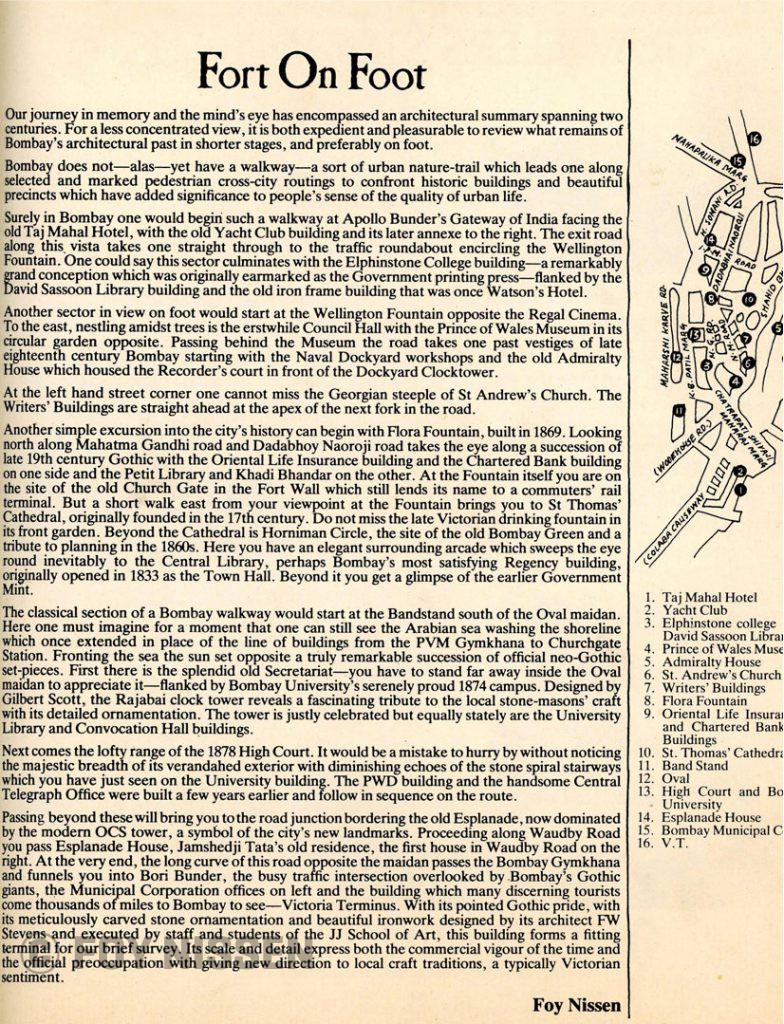
Fort on Foot
Our journey in memory and the mind’s eye has encompassed an architectural summary spanning two centuries. For a less concentrated view, it is both expedient and pleasurable to review what remains of Bombay’s architectural past in shorter stages, and preferably on foot.
Bombay does not–alas–yet have a walkway–a sort of urban nature-trail which leads one along selected and marked pedestrian cross-city routings to confront historic buildings and beautiful precincts which have added significance to people’s sense of the quality of urban life.
Surely in Bombay one would begin such a walkway at Apollo Bunder’s Gateway of India facing the old Taj Mahal Hotel, with the old Yacht Club building and its later annex to the right. The exit rod along this vista takes one straight through to traffic roundabout encircling the Wellington Fountain. One could say this sector culminates with the Elphinstone College building a remarkably grand conception which was originally earmarked as the Government printing press__flanked by the David Sassoon Library building and the old iron frame building that was once Watson,s Hotel.
Another sector in view on foot would start at the Wellington Fountain opposite the Regal Cinema. To the east, nestling amidst trees is the erstwhile Council Hall with the prince of Wales Museum in its circular garden opposite. Passing behind the Museum the road takes one past vestiges of late. eighteenth century Bombay starting with the Naval Dockyard workshops and the old Abmiralty House which housed the Recorder’s court in front of the Dockyard Clocktower.
At the left hand street corner one connote miss the georgian steeple of St Andrew’s Church. The Writers’ Buildings are straight ahead at the apex of the next fork in the road.
Another simple excursion into the city’s history con begin with Fountain, built in 1869. Looking north along Mahatma Gandhi road and Dadabhoy Naoroji road takes the eye along a succession of late19th century Gothicn with the Oriental life Insurance building and the Chartered Bank building on one side and the petit Library and Khadi Bhandar on the other. At the Fountain itself you are on the site of the old Church Gate in the Fort Wall which still lends its name to a commuters’ rail
terminal. But a short walk east from your viewpoint at the Fountain brings you to St Thomas’ Cathedral, originally founded in the 17th century. Do not miss the late Victorian bricking fountain in its front garden . Beyond the Cathedral is Horniman Circld, the site of the old Bombay Green and a tribute to planning in the 1860s. Here you have an elegant surrounding arcade arcade which sweeps the eye round inevitably to the Central library, perhaps Bombay’s most satisfying Regency building,
originally opened in 1833as the Town Hall. Beyond it you get a glimpse of the earlier Government Mint.
The classical section of a Bombay walkway would start at Bandstand south of the Oval maiden. Here one must imaging for a moment that one cam still see the Arabian sea washing the shoreline which once extended in place of the line of buildings from the PVM Gymkhana to Churchgate Station. Fronting the sea the sun set opposite a truly remarkable succession of official neo Gothic set__pieces. First there is the splendid old Secretariat–you have to stand far away inside the Oval maiden to appreciate it_flanked by Bombay University’s serenely proud 1874 campus. Designed by Gilbert Scott, the Rajabai clock tower reveals a fascinating tribute to the local stone_masons,
craft with its detailed ornamentation.The tower is justly celebrated but equally stately are the University Library and Convocation Hall buildings.
Next comes the lofty range of the 1878 HIgh Court. It would be a mistake to hurry by without noticing the majestic breadth of its verandahrd exterior with demising echoes of the stairways which you have just seen on the University building. The PWD building and the handsome Central Telegraph Office were built a few years earlier and follow in sequence on the route.
Passing beyond these will bring you to the road junction bordering the old Esplanade, now dominated by the modern OCS tower, a symbol of the city’s new landmarks. Proceeding along waudby Road you pass Esplanade House, Jamshedji Taja’s old residence, the first house in Waudby Road on the
right. At the very end, the long curve of this road opposition the maiden passes the Bombay Gymkhana and funnels you into Bori Bunder , the busy traffic intersection overlooked by Bombay Gothic giants, the Municipal Corporation office on left and the building which many discerning tourists come thousands of miles to Bombay to see Victoria Terminus. With its pointed Gothic pride, with its meticulously carved stone ornamentation and beautiful iromwoek designed by its architect FW Stevens and executed by staff and students of the JJ School of Art, this building forms a fitting terminal for our brief survey. Its scale and detail express both the commercial vigor of the time and tae official preoccupation with giving new direction to local craft traditions, a typically Victorian sentiment.
